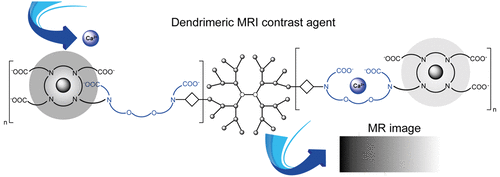当前位置:
X-MOL 学术
›
Biomacromolecules
›
论文详情
Our official English website, www.x-mol.net, welcomes your
feedback! (Note: you will need to create a separate account there.)
Synergy of Key Properties Promotes Dendrimer Conjugates as Prospective Ratiometric Bioresponsive Magnetic Resonance Imaging Probes
Biomacromolecules ( IF 5.5 ) Pub Date : 2018-11-09 00:00:00 , DOI: 10.1021/acs.biomac.8b01425 Liam Connah 1 , Goran Angelovski 1
Biomacromolecules ( IF 5.5 ) Pub Date : 2018-11-09 00:00:00 , DOI: 10.1021/acs.biomac.8b01425 Liam Connah 1 , Goran Angelovski 1
Affiliation

|
Bioresponsive or smart contrast agents (SCAs) sensitive to Ca2+ are of extreme interest in the development of functional magnetic resonance imaging (MRI) techniques as they can aid in tracking neural activity in vivo. To this end, the design of macromolecular systems based on nanoscaffolds such as dendrimers functionalized with multiple MRI contrast agents has been used to conveniently increase the local concentration of paramagnetic MR reporters and slow the diffusion time of the probe, which are favorable in vivo characteristics. Moreover, previous studies with Ca-sensitive dendrimeric MRI probes revealed favorable properties crucial in the development of a ratiometric T2/T1-imaging method that provided a higher contrast-to-noise ratio compared to conventional T1- or T2-weighted imaging protocols. We therefore developed a series of novel dendrimeric MRI probes (DCAs) with differing structural properties and charge distributions. We thoroughly studied their features such as the relaxometric behavior and size change and examined their electrostatic behaviors prior to and after the addition of Ca2+. The most active DCA displayed a common increase in r1 (3.11 to 5.72 mM–1 s–1) and a remarkable increase in r2 (7.44 to 34.57 mM–1 s–1), resulting in a r2/r1 ratio increase of the factor 2.52, which is greater than what was previously achieved. These changes in r1 and r2 were followed with a hydrodynamic diameter increase from 7.1 ± 1.2 to 8.5 ± 0.7 nm upon the addition of Ca2+, along with a decrease in the negative surface charge of the nanoparticle. Overall, our findings indicate that highly responsive DCAs can be developed only through a combination of properties such as changes in hydration and size of the molecule, which are a consequence of intramolecular structural and electrostatic changes in the particle. In turn, they provide a model for future preparations of responsive DCAs that can be utilized for both T1-weighted and ratiometric T2/T1-weighted imaging to visualize essential biological processes in a dynamic fashion.
中文翻译:

关键特性的协同作用促进树枝状大分子共轭,作为预期的比例式生物响应磁共振成像探针。
对Ca 2+敏感的生物响应性或智能造影剂(SCA)在功能磁共振成像(MRI)技术的开发中引起了极大的兴趣,因为它们可以帮助跟踪体内的神经活动。为此,基于纳米支架的大分子系统的设计,例如用多种MRI造影剂功能化的树状聚合物,已被用来方便地增加顺磁性MR报告分子的局部浓度并减慢探针的扩散时间,这是有利的体内特性。此外,先前对Ca敏感的树枝状MRI探针的研究表明,有利的性质对比例T 2 / T 1的发展至关重要-成像方法,与传统的T 1-或T 2-加权成像协议相比,具有更高的对比度-噪声比。因此,我们开发了一系列具有不同结构特性和电荷分布的新型树枝状MRI探针(DCA)。我们彻底研究了它们的特征,如弛豫行为和尺寸变化,并检查了在添加Ca 2+之前和之后的静电行为。最活跃的DCA显示出r 1的共同增加(3.11至5.72 mM –1 s –1)和r 2显着增加(7.44至34.57 mM –1 s –1)),导致r 2 / r 1比率增加了2.52,这比以前实现的要大。添加Ca 2+后,随着r 1和r 2的这些变化,流体动力学直径从7.1±1.2纳米增加到8.5±0.7 nm。,以及纳米粒子负表面电荷的减少。总的来说,我们的发现表明,只有通过结合诸如分子的水合作用和分子大小变化等特性,才能开发出高响应性DCA。反过来,它们为将来准备响应式DCA提供了一个模型,该模型可用于T 1加权和比例T 2 / T 1加权成像,以动态方式可视化基本的生物过程。
更新日期:2018-11-09
中文翻译:

关键特性的协同作用促进树枝状大分子共轭,作为预期的比例式生物响应磁共振成像探针。
对Ca 2+敏感的生物响应性或智能造影剂(SCA)在功能磁共振成像(MRI)技术的开发中引起了极大的兴趣,因为它们可以帮助跟踪体内的神经活动。为此,基于纳米支架的大分子系统的设计,例如用多种MRI造影剂功能化的树状聚合物,已被用来方便地增加顺磁性MR报告分子的局部浓度并减慢探针的扩散时间,这是有利的体内特性。此外,先前对Ca敏感的树枝状MRI探针的研究表明,有利的性质对比例T 2 / T 1的发展至关重要-成像方法,与传统的T 1-或T 2-加权成像协议相比,具有更高的对比度-噪声比。因此,我们开发了一系列具有不同结构特性和电荷分布的新型树枝状MRI探针(DCA)。我们彻底研究了它们的特征,如弛豫行为和尺寸变化,并检查了在添加Ca 2+之前和之后的静电行为。最活跃的DCA显示出r 1的共同增加(3.11至5.72 mM –1 s –1)和r 2显着增加(7.44至34.57 mM –1 s –1)),导致r 2 / r 1比率增加了2.52,这比以前实现的要大。添加Ca 2+后,随着r 1和r 2的这些变化,流体动力学直径从7.1±1.2纳米增加到8.5±0.7 nm。,以及纳米粒子负表面电荷的减少。总的来说,我们的发现表明,只有通过结合诸如分子的水合作用和分子大小变化等特性,才能开发出高响应性DCA。反过来,它们为将来准备响应式DCA提供了一个模型,该模型可用于T 1加权和比例T 2 / T 1加权成像,以动态方式可视化基本的生物过程。











































 京公网安备 11010802027423号
京公网安备 11010802027423号